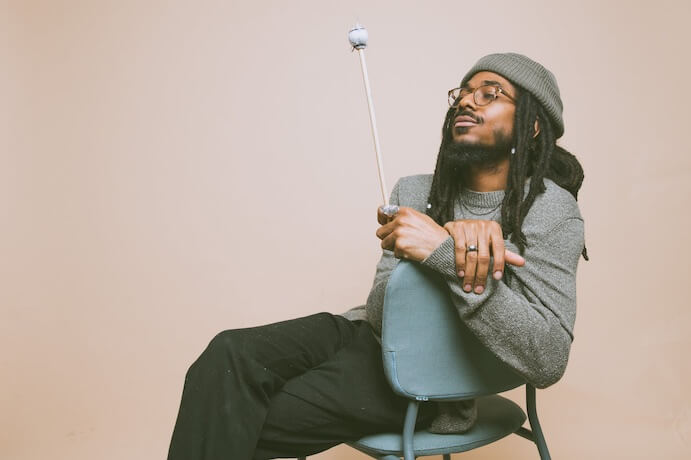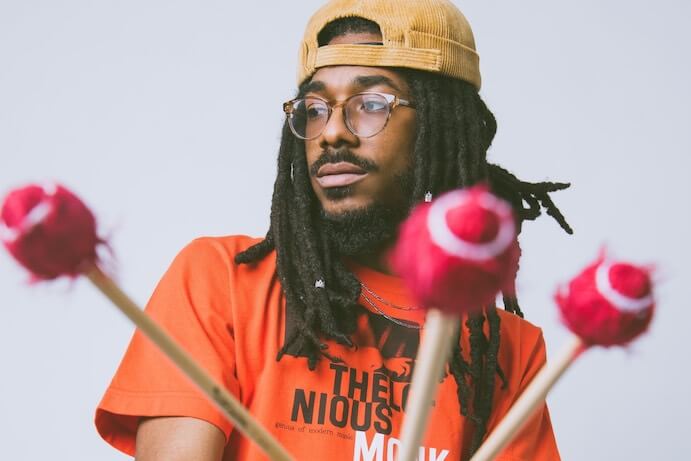From the very first note dropped by Joel Ross’ mallet at The Jazz Gallery on May 14, 2022, the audience is gentled. His opening solo in “Prayer,” the first track on his newest album, The Parable of the Poet (Blue Note Records), gives us the vibraphone we don’t often get to hear anymore: the long-sustained, vibrato-motor-on, penetrating notes that can’t be heard from any other instrument, including the voice. Ross is taking up space with percussionist-composers across a span of styles and genres, himself a next-generation jazz vibraphonist Stefon Harris. Similarly to Harris, Ross embraces the purity of the sound in vibraphone even while pushing past the style of greats like Sasha Berliner.
While contemporary classical percussion moves more in a direction using electronics, spearheaded by composers like Andy Akiho and mastered by composers such as Patricia Brennan and Ted Babcock, Joel Ross is doing the opposite — neither afraid nor ashamed of the beauty of the unaltered instrument. Ross doesn’t take off flying in flurries, too fast to recognize what is being played. Each metal slab of the vibraphone isn’t choked at the same moment that it is struck. He doesn’t hide the sustain pedal, nor pretend that the motor is broken.

The hazy opening solo of “Prayer” reflected the weather that night: heavy fog, thick humid air, so dense the tops of the skyscrapers lining 9th Avenue couldn’t be seen. Tenor sax (Sergio Tabanico), alto sax (Immanuel Wilkins), trombone (Kalia Vandever), trumpet (Marquis Hill), and flute (Gabrielle Garo) traded a lazy repeated five-note melody, breaking off different sections of the band without knowing exactly where they were headed. The melody came out not as a line of notes, but an enveloping sensation, an atmosphere for the room. The repetition didn’t sit still as one section moves ahead of another. Pushing and pulling, then catching up after a breathless race, this five-note theme never went away as Ross soloed on top of it all, pecking at an idea that eventually broke through but quickly slipped back underneath the band.
Ross spent a lot of time standing back and listening as part of the audience before jumping back in. The Jazz Gallery has an L-shaped floor plan, the hook of the L being where Ross stood, unseen by most of the audience. The venue changed how the audience could hear Ross with their eyes, which in some ways made the concert inaccessible, yet in other ways fit the character of how Ross used his presence (or rather, absence) in the music.
The wind instruments dropped out and gave way to the piano, drums, and bass. The piano (Micah Thomas) and drums (Craig Weinrib) spoke to each other, exchanging short, quick, rhythmically complex riffs. Fast and choppy, they sounded upset. Then, a bass solo (Rick Rosato) lead into the next parable. Vibes snuck in with ruffles and truffles after the drum set so lightly brought in a pulse merely to show proof of life. Soon, the wind instruments came back in before a flute solo cut through the smoke. Ross improvised under the band most of the time, which mimicked an orchestra with solos bursting through like that of the concertmaster in Rimsky-Korsakov’s Scheherazade. But eventually the vibraphone pulled out on top, ascending from the low register of the instrument to the top register.

Then came a smushing of alto sax and tenor sax that sounded like two women crying, much like Ornette Coleman’s “Lonely Woman.” Played so well, the instruments truly did mimic the human voice. After a scattering saxophone solo over drum set with the sound of a lover’s quarrel, the piano comforted the distress with a mix between punctuating a pastor’s sermon and the soprano gospel singer ad-libbing on top of the choir. Like the Holy Spirit climax at church, the roundness of the sound grew, then filled the room until it took up every corner. All the while, Ross stood in the hook of the L and played beneath the band. It was easy to forget that this was a Joel Ross concert — he didn’t take the stage to talk to the audience at any point in the show except for an introduction of the musicians at the end. But when he soloed, the concert became his show again.
There is a special quality to hearing Ross’ new album performed live, like the difference between being at a church revival in person versus listening to a recording of one. Parable of the Poet is aptly named for the religious mystery of parables combined with the literary need for poetry to feel an idea beyond just reading about one. And Joel Ross executes both especially well.
I CARE IF YOU LISTEN is an editorially-independent program of the American Composers Forum, funded with generous donor and institutional support. Opinions expressed are solely those of the author and may not represent the views of ICIYL or ACF.
A gift to ACF helps support the work of ICIYL. For more on ACF, visit the “At ACF” section or composersforum.org.
























